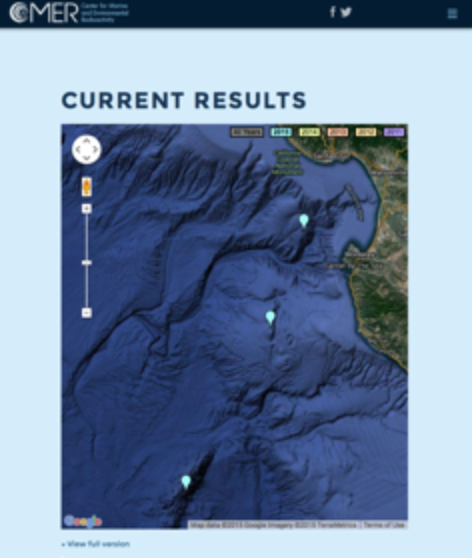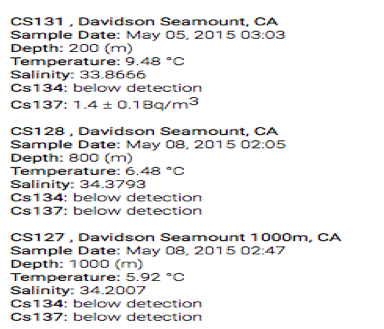Woods Hole Oceanographic Institution
Save The Earth funded research to collect and analyze water samples for radioactivity from Fukushima in the ocean offshore of Central California.

Three locations (light blue markers) offshore of Central California where water samples were collected for Fukushima radionuclide testing (north to south): eastern Smooth Ridge, Sur Ridge, and Davidson Seamount. Credit: Woods Hole Oceanographic Institution.

Radioactivity results from Davidson Seamount at 200 meters, 800 meters, and 1000 meters depth. No radioactivity from Fukushima (Cesium-134) was detected. Credit: Woods Hole Oceanographic Institution.
Woods Hole Oceanographic Institution (WHOI) started a citizen science project collecting ocean water samples because of the concern from the public about radionuclides from Fukushima washing ashore in North America.
Although the best ocean models predicted only very low levels to reach North America, people were still concerned and wanted to see real data. So WHOI decided to create this project as a way to educate people about environmental radioactivity in general, and also to provide them with actual data from their local beaches. So far it has been a huge success, with over 400 individual donations from the public and 100 samples proposed and/or funded already. Many of these samples have been collected and the data are posted on WHOI’s website (http://ourradioactiveocean.org).
Most of the samples collected to date have been from nearshore waters, due to the interests of crowd source funders (e.g., local beaches). Save the Earth wanted to test offshore waters, particularly over the Davidson Seamount (where we have an ongoing interest because of our role in designating this area as a protected Sanctuary) and in other Sanctuary Ecologically Significant Areas. The water samples were tested for the presence of radioisotopes released from Fukushima (Cesium-134). Therefore, these water samples from offshore sites are valuable for filling out the eastern North Pacific Ocean data set.
Save The Earth provided funding for the collection and analysis of seven water samples at three locations: eastern Smooth Ridge, Sur Ridge, and Davidson Seamount. None of the seven water samples had detectable amounts of Cesium-134 from Fukushima, but it can be detected more and more at sample sites moving west across the Pacific towards Japan.